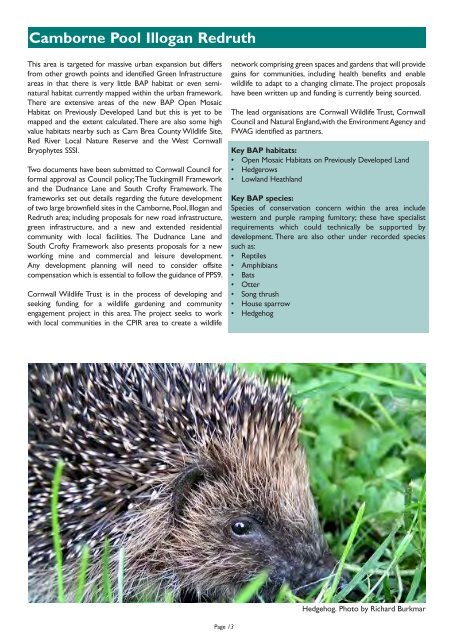Cornwall's Biodiversity Action Plan - Cornwall Wildlife Trust
Cornwall's Biodiversity Action Plan - Cornwall Wildlife Trust
Cornwall's Biodiversity Action Plan - Cornwall Wildlife Trust
You also want an ePaper? Increase the reach of your titles
YUMPU automatically turns print PDFs into web optimized ePapers that Google loves.
Camborne Pool Illogan Redruth<br />
This area is targeted for massive urban expansion but differs<br />
from other growth points and identified Green Infrastructure<br />
areas in that there is very little BAP habitat or even seminatural<br />
habitat currently mapped within the urban framework.<br />
There are extensive areas of the new BAP Open Mosaic<br />
Habitat on Previously Developed Land but this is yet to be<br />
mapped and the extent calculated. There are also some high<br />
value habitats nearby such as Carn Brea County <strong>Wildlife</strong> Site,<br />
Red River Local Nature Reserve and the West <strong>Cornwall</strong><br />
Bryophytes SSSI.<br />
Two documents have been submitted to <strong>Cornwall</strong> Council for<br />
formal approval as Council policy; The Tuckingmill Framework<br />
and the Dudnance Lane and South Crofty Framework. The<br />
frameworks set out details regarding the future development<br />
of two large brownfield sites in the Camborne, Pool, Illogan and<br />
Redruth area; including proposals for new road infrastructure,<br />
green infrastructure, and a new and extended residential<br />
community with local facilities. The Dudnance Lane and<br />
South Crofty Framework also presents proposals for a new<br />
working mine and commercial and leisure development.<br />
Any development planning will need to consider offsite<br />
compensation which is essential to follow the guidance of PPS9.<br />
<strong>Cornwall</strong> <strong>Wildlife</strong> <strong>Trust</strong> is in the process of developing and<br />
seeking funding for a wildlife gardening and community<br />
engagement project in this area. The project seeks to work<br />
with local communities in the CPIR area to create a wildlife<br />
network comprising green spaces and gardens that will provide<br />
gains for communities, including health benefits and enable<br />
wildlife to adapt to a changing climate. The project proposals<br />
have been written up and funding is currently being sourced.<br />
The lead organisations are <strong>Cornwall</strong> <strong>Wildlife</strong> <strong>Trust</strong>, <strong>Cornwall</strong><br />
Council and Natural England,with the Environment Agency and<br />
FWAG identified as partners.<br />
Key BAP habitats:<br />
• Open Mosaic Habitats on Previously Developed Land<br />
• Hedgerows<br />
• Lowland Heathland<br />
Key BAP species:<br />
Species of conservation concern within the area include<br />
western and purple ramping fumitory; these have specialist<br />
requirements which could technically be supported by<br />
development. There are also other under recorded species<br />
such as:<br />
• Reptiles<br />
• Amphibians<br />
• Bats<br />
• Otter<br />
• Song thrush<br />
• House sparrow<br />
• Hedgehog<br />
Hedgehog. Photo by Richard Burkmar<br />
Page 13

















